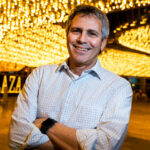Across Las Vegas, Formula One leaves its mark

Just as the green flag signaled the start of the Formula One Las Vegas Grand Prix on Saturday at 10 p.m., four of the five large television screens inside the off-Strip Palms Casino Resort’s sportsbook were trained on the race.
The other monitor showed the New Mexico-Fresno State football game, one of the few games still being played during the day’s full slate of college action.
Adam Fayson and Michael Garcia, however, had their eyes focused on one of the many smaller monitors showing the San Diego State-San Jose State game. Both customers had “some heavy action” on the under at 37.5, meaning the combined final score could be more than that figure.
The two and another friend let out a large cheer when the game ended with a 24-13 San Jose State victory.
But would the football fans turn their eyes — and more importantly their betting dollars — to the highly anticipated F1 race?
“No, but we’ll give it [a] watch,” Garcia said.
Another Palms sports gambler had a different view of the race. He had a moneyline wager on New Mexico beating Fresno State and heavily invested in watching the game as it was well into the fourth quarter when the race began.
The customer, who didn’t provide his name, said he couldn’t care less about the grand prix.
Depending on where you were Saturday night, sitting in a swanky luxury suite and dining on meals prepared by celebrity chefs, in grandstands along the 3.8-mile racing circuit, or inside a local casino sportsbook, the perception of the race differed.
At the Palms, televisions at bars throughout the casino were turned to the race, but there was little viewing interest.
Lorenzo Burru, a native of Italy now living in Las Vegas, was the exception. He was focused on watching the race from a plush seat in the Palms sportsbook, which is operated by Caesars Entertainment-owned William Hill US. Wearing a red tracksuit with a Ferrari logo, it was clear what team had his support, although he didn’t have a bet on the race.
When the two Ferrari cars were both involved in a multiracer mishap on Turn 1 at the start of the race, Burru cringed. But his fears were short-lived as Ferrari driver Charles Leclerc finished second and fellow Ferrari teammate Carlos Sainz Jr., who had spun out, recovered to finish sixth.
Burru said he wanted to attend the race, but he was happy to be at the Palms, where there was sparse interest.

Across town at Ellis Island, the interest was at a much higher level. Operators of the off-Strip casino were ecstatic over the response from F1 fans and customers.
The 300-room family-owned casino sits along Koval Lane one block east of the Strip and just north of the race’s Turn 4 leaving the pit area. Ellis Island signed a partnership with Formula One as an official venue of the race and the hotel-casino offered 1,100 grandstand seats at the front of the property.
“Ellis Island's Turn 4 events were a huge success," said Christina Ellis, the casino’s vice president of development. "Our grandstands and Beer Garden Experience were completely sold out for Saturday's race, and we couldn't be more proud of our team.”
Anamarie Ellis, vice president of operations, said the small casino was filled with both regular customers and out-of-town visitors.
“We're thrilled that our regulars and new guests had such an incredible weekend,” she said.
Interest in the race was just as strong far from the track at Red Rock Resort in Summerlin.
Around 11 p.m., when the race was more than halfway complete, an estimated 250 watched from seats normally packed with football fans. The sportsbook bar was also filled with race fans. Two of the three large television screens showed the race with the third switching over after New Mexico’s 25-17 win over Fresno.
The space erupted with cheers when driver Sergio “Checo” Perez took over the lead on the 33rd lap.
Enthusiasm for the race continued until its conclusion with world champion Max Verstappen’s late-race victory.
One sportsbook customer, who didn’t want her name used, said she splits her time between homes in Las Vegas and Texas and attended the F1 race in Austin last month.
“It's cool to have the race in Las Vegas. Maybe we’ll attend next year,” she said.
For Spencer Schuessler and his two friends, a high-top table in the Red Rock sportsbook provided a different setting from Friday night when they ventured to the Strip to watch the qualifying.
Without tickets, they found some standing-room space in front of The Cosmopolitan.
“We considered going back to the Strip, but we decided to come to Red Rock so we could watch the whole race,” said Schuessler, who is a motorsports fan. “I told these guys if F1 comes to Vegas we have to find a way to go.”
Wagering on motorsports doesn’t rise to a category under the Gaming Control Board’s track of sports betting, with the figures lumped into the “other sports” category.

The local experience
Some valley locals took advantage of free community showings put together by the county at the Clark County Government Center Amphitheater, Nellis Air Force Base and Water Street Plaza in Henderson.
A crowd of around 200 sat on lawn chairs and blankets in front of a screen at the government center amphitheater, some grabbing coffee and hot chocolate from a local vendor to keep warm.
Gabby Cruz, a longtime fan of motorsports, said she’s already looking forward to next year’s race despite being “priced out” of being able to attend the inaugural Las Vegas Grand Prix weekend.
“I'm glad the county offered this opportunity to watch the race. I snagged those free tickets up real quick. I think I was the first one to jump on it and I ran around the office all excited,” Cruz said before the race.
Although excited to watch the race and root for Perez, Cruz admitted complaining about the traffic on the Strip but attributes it to “growing pains.”
“I think most locals that are complaining are locals that are not fans,” she said. “This is growing pains. It's the first year; there's gonna be a lot of hiccups. What hurt me the most were the trees that were cut down [at the Bellagio Hotel and Casino].”
As the race began, cheers rolled through the amphitheater with spectators looking at the screen, some with their phones out waiting to catch the first few moments of the race.
Ryan Huestis said his love for cars began after watching Disney’s Pixar Cars as a child. He has followed Formula One and the Ferrari Team “religiously” for three years now because of “their history and their prowess in the racing world.”
“I was really stoked to see my favorite sport would be in my hometown,” Huestis said.


What comes next
As the F1 circus leaves for the season finale in Abu Dhabi this weekend, eyes have already turned to the 2024 Las Vegas Grand Prix.
For organizers, it came early Saturday in the form of the announcement that ticket deposits for 2024 were already open. A deposit for a seat in the grandstands or general admission would run $250, a private suite, $5,000.
But for the city, county and the city’s tourism leaders, there are a battery of questions and policy decisions that must be answered between now and next year’s race.
Among them is the question of logistics and what may become of some of the most disruptive road F1 road closures unrelated to repaving city streets (a process that will likely not need repeating for several years).
At the top of the list, Las Vegas Convention and Visitors Authority (LVCVA) CEO Steve Hill said, will be what to do about the temporary bridge built over Flamingo Road and Koval Lane, a stopgap solution for race-day closures that still allows limited traffic access inside the closed circuit.
Few elements of F1 preparation in Las Vegas caused as much frustration for Las Vegas locals as much as road closures, many of which choked back roads that provide property access for tens of thousands of Strip employees.
However, Hill said no single F1 road closure created more headaches for locals than the total shuttering of the Flamingo-Koval intersection for 10 days. That process will likely repeat next month as the bridge is removed, alongside the rest of the temporary race infrastructure over the next six to eight weeks. But improved traffic flow with the bridge installed could spur officials to consider a new, permanent bridge.
“That was not good, it was really not good,” Hill said of the closure. “[But] frankly, traffic is better with that bridge there than when it's not there outside of the race time. Trying to come up with a better plan [on Flamingo] I think is certainly a possibility.”
And at some point in the undetermined future, Clark County commissioners must make a call on the request by race organizers to split the $80 million cost of repaving the track 50-50. Asked about the money during a press conference held a week before the race, commission Chair Jim Gibson told reporters that “there are a lot of pieces and parts to the whole thing and we’ll work through that in due course.”
“We’ve all agreed to postpone all of that because the event has driven or taken so much of the energy and time that it really needs to be something that we separate from the preparations for the event,” Gibson said.
Also unclear is the degree to which employee transit during the race could shift in future years. Ahead of the inaugural race, county authorities, the Culinary Workers Union and the LVCVA all raised concerns over the logistics of transporting tens of thousands of employees inside a “hot track,” a Strip completely closed to outside traffic.
This year, authorities relied on a mix of solutions — many of which involved alternate parking and a long walk. Some employees were given tickets to the monorail. The LVCVA authorized a busing contract to move employees back in October. Wynn Resorts created a new parking lot across from the former Frontier site after access to the company’s employee parking structure on Koval — a functional part of the circuit — was blocked.
Ultimately, Hill said he thought, “at some level,” some Las Vegas locals who have had to put up with this might see the race differently now that year one is in the rearview mirror — “there's a sense of community pride when you pull something like this off,” he said.
“But it's not big enough to overcome the fact that, if you gotta go to work every day for two or three months and you have to sit in traffic that's extra because [F1] is there, those two things don't offset each other in the minds of those folks,” Hill said.



